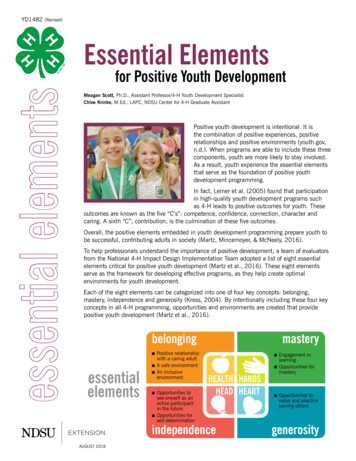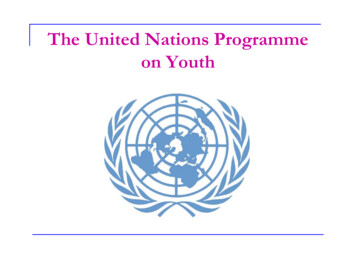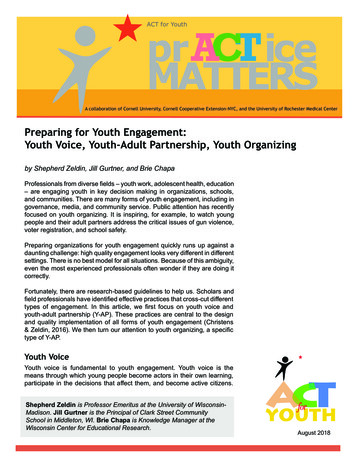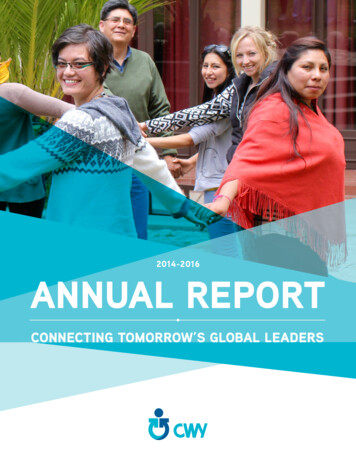
Transcription
YD1482(Revised)Essential Elementsessential elementsfor Positive Youth DevelopmentMeagan Scott, Ph.D., Assistant Professor/4-H Youth Development SpecialistChloe Krinke, M.Ed., LAPC, NDSU Center for 4-H Graduate AssistantPositive youth development is intentional. It isthe combination of positive experiences, positiverelationships and positive environments (youth.gov,n.d.). When programs are able to include these threecomponents, youth are more likely to stay involved.As a result, youth experience the essential elementsthat serve as the foundation of positive youthdevelopment programming.In fact, Lerner et al. (2005) found that participationin high-quality youth development programs suchas 4-H leads to positive outcomes for youth. Theseoutcomes are known as the five “C’s”: competence, confidence, connection, character andcaring. A sixth “C”, contribution, is the culmination of these five outcomes.Overall, the positive elements embedded in youth development programming prepare youth tobe successful, contributing adults in society (Martz, Mincemoyer, & McNeely, 2016).To help professionals understand the importance of positive development, a team of evaluatorsfrom the National 4-H Impact Design Implementation Team adopted a list of eight essentialelements critical for positive youth development (Martz et al., 2016). These eight elementsserve as the framework for developing effective programs, as they help create optimalenvironments for youth development.Each of the eight elements can be categorized into one of four key concepts: belonging,mastery, independence and generosity (Kress, 2004). By intentionally including these four keyconcepts in all 4-H programming, opportunities and environments are created that providepositive youth development (Martz et al., 2016).belongingnessentialelementsnnnnPositive relationshipwith a caring adultA safe environmentAn inclusiveenvironmentOpportunities tosee oneself as anactive participantin the futureOpportunities forself-determinationmasterynnHEALTH HANDSHEAD HEARTindependenceAUGUST 2018nEngagement inlearningOpportunities formasteryOpportunities tovalue and practiceserving othersgenerosity
belongingbelongingPositive Relationship With aYouth need caring and supportive relationships in their lives. They need adults to learn abouttheir interests and pay attention to them outside of meetings, events and other regularlyorganized activities. By offering a listening ear, focusing on a young person’s strengths andproviding a positive environment, adults help youth experience a sense of belonging.What Adults Can Do:n Intentionally listen to youth.n Structure programs so youth and adults have the opportunity tointeract and learn about one another.n Use nametags so everyone is on a first-name basis.n Encourage youth-adult partnerships where youth and adults havea voice in decision-making, rather than adults acting solely aschaperones or supervisors.ASafe EnvironmentFor youth to be engaged in programming, they must feel comfortable with their surroundingsand never fear physical or emotional harm. For example, bullying, cliques and put-downs nevershould be tolerated. Adults need to be trained in safety and child protection, and safety plansshould be incorporated into all programming to foster a sense of belonging among the youth.What Adults Can Do:nnnnBe consistent when dealing with misbehavior.Ensure all adult leaders and volunteers are screened and trained prior to working with youth.Engage youth in the planning, implementation and evaluation of programs.Ask youth to suggest ways to improve the group’s environment.belongingAnHEALTHCaring AdultInclusive EnvironmentConnecting with otherpeople and buildinginterpersonal relationshipsallows a sense of belongingto develop. Youth whoencourage one another,offer positive feedback andcelebrate the efforts of allgroup members cultivate aninclusive environment that is welcoming to youth from a variety of backgrounds.What Adults Can Do:belongingn Involve everyone from the beginning by doing icebreakers and developing rulesfor participation and behavior.n Provide multiple forms of recognition, not just for youth who excel in competition.n Actively work to diversify the group.n Use T-shirts, hats or other items to denote group membership.Essential Elements for Positive Youth Development www.ag.ndsu.edu/extension2
masterymasteryEngagement in LearningmasteryHANDSLearning opportunities beyond school and work are necessary for mastery of the skills requiredto be successful in today’s competitive world. Therefore, youth should develop competenciesthrough educational experiences outside of the academic classroom. When youth are engagedin learning, they are more likely to develop high levels of self-motivation and creativity.What Adults Can Do:n Provide opportunities that intellectuallystimulate and challenge youth.n Encourage group members to worktogether to plan activities.n Offer different ways for youth to learn(auditory, visual, verbal, physical, logical).n Allow youth to experience what they havelearned by performing their new skillsthrough opportunities such as publicspeaking, serving on a planning committeeor judging a 4-H event.Opportunities for MasteryBuilding knowledge and skills and then demonstrating competency as a proficient practitionercan be described as mastery. However, the level of mastery is dependent upon thedevelopmental ability of the youth and is a process that takes place through time. Althoughmastery may be rewarded by youth organizations in the form of a ribbon, badge or scholarship,the true rewards for youth are self-confidence and knowing they completed a “job well done.”What Adults Can Do:n Offer opportunities for youth to practiceand demonstrate their skills.n Plan developmentally appropriate activitiesto accommodate diverse learning styles.n Provide opportunities for youth to teachand mentor others.n Allow time for youth to reflect onsuccesses, setbacks and growth.masteryEssential Elements for Positive Youth Development www.ag.ndsu.edu/extension3
independenceOpportunities to See Oneself as anActive Participant in the FutureindependenceindependenceHEADYouth who envision their future have hope. They aremore likely to make positive life choices and acceptresponsibility for their actions. Adult leaders play avital role as they help youth recognize the connectionbetween independence and responsibility. Youth benefitfrom knowing their future is worth working for, and thatthey have supportive adult leaders to guide them intheir journey toward independence.What Adults Can Do:n Encourage youth to set and record goals for thefuture that are challenging but achievable.n Provide opportunities for youth to reach some oftheir goals through meetings, programs and projects.n Give youth the opportunity to develop an idea fromstart to finish.n Allow youth to make plans for the upcoming year.Opportunities forSelf-determinationSelf-determination occurs when youth believe they have an impact on the events in their lives.To become self-directing, autonomous adults, youth must have a sense of influence and controlin their lives. Youth should be given opportunities to practice decision-making skills becauseindependence is an important aspect of transitioning into an independent adult.What Adults Can Do:n Provide an environment in which youthcan try new things and challengethemselves safely.n Give youth numerous opportunities toset personal goals that align with theirvalues.n Allow youth to solve their own problems.Be supportive, but allow them todiscover their own solutions.n Encourage youth to choose and planorganizational activities, team events andother projects.independenceEssential Elements for Positive Youth Development www.ag.ndsu.edu/extension4
generosityOpportunities to Value and PracticeServing OthersgenerosityYouth need to feel as though their lives have meaning and purpose. When young peopleserve others, they have the opportunity to connect with their communities and give back.Service learning goes a step beyond community service because learning is the primary goaland service is secondary.When youth are given the opportunity to plan, implement and then reflect upon a project,they gain a sense of meaning and purpose. What they gain through a service learningproject is far more than what they may obtain by solely participating in a community serviceproject. Ultimately, youth develop a sense of generosity.What Adults Can Do:nnnnLook for opportunities to incorporate service learning as part of project activities.Encourage youth to identify community needs and design solutions to meet those needs.Establish opportunities for youth to volunteer their time, interests or skills.Provide experiences for youth to learn more about their community through projectsthat bring them in contact with people from local agencies, government or ntial Elements for Positive Youth Development www.ag.ndsu.edu/extension5
Referencesessential elementsKress, C. (2004). Essential elements of 4-H youth development. National 4-H Headquarters, CSREES USDA.Lerner, R.M., Lerner, J.V., Almerigi, J., Theokas, C., Phelps, E., Gestsdottir, S., . von Eye, A. (2005). Positiveyouth development, participation in community youth development programs, and community contributionsof fifth grade adolescents: Findings from the first wave of the 4-H Study of Positive Youth Development.Journal of Early Adolescence, 25(1), 17 – 71.Martz, J., Mincemoyer, C., & McNeely, N.N. (2016). Essential elements of 4-H youth development programs:Curriculum and training guide. Washington, D.C.: National 4-H Council.youth.gov (n.d.). Positive youth development. Retrieved from egenerosityOriginal publication authored by:Sharon Query, 4-H Youth Development Specialist, NDSU ExtensionKatie Lefor, Graduate Assistant, NDSU Center for 4-HMarch 2010NDSU Extension does not endorse commercial products or companies even though reference may be made to tradenames, trademarks or service names. NDSU encourages you to use and sharethis content, but please do so under the conditions of our Creative Commons license. You may copy, distribute, transmit and adapt this work as long as you give full attribution, don’t use the work forcommercial purposes and share your resulting work similarly. For more information, visit www.ag.ndsu.edu/agcomm/creative-commons.County commissions, North Dakota State University and U.S. Department of Agriculture cooperating. NDSU does not discriminate in its programs and activities on the basis of age, color, gender expression/identity, genetic information, marital status, national origin, participation in lawful off-campus activity, physical or mental disability, pregnancy, public assistance status, race, religion, sex, sexualorientation, spousal relationship to current employee, or veteran status, as applicable. Direct inquiries to Vice Provost for Title IX/ADA Coordinator, Old Main 201, NDSU Main Campus, 701-231-7708,ndsu.eoaa@ndsu.edu. This publication will be made available in alternative formats for people with disabilities upon request, 701-231-7881.AUGUST 2018Essential Elements for Positive Youth Development www.ag.ndsu.edu/extension6
n Give youth the opportunity to develop an idea from start to finish. n Allow youth to make plans for the upcoming year. Opportunities for Self-determination Self-determination occurs when youth believe they have an impact on the events in their lives. To become self-directing, autonomous adults, youth must have a sense of influence and control










